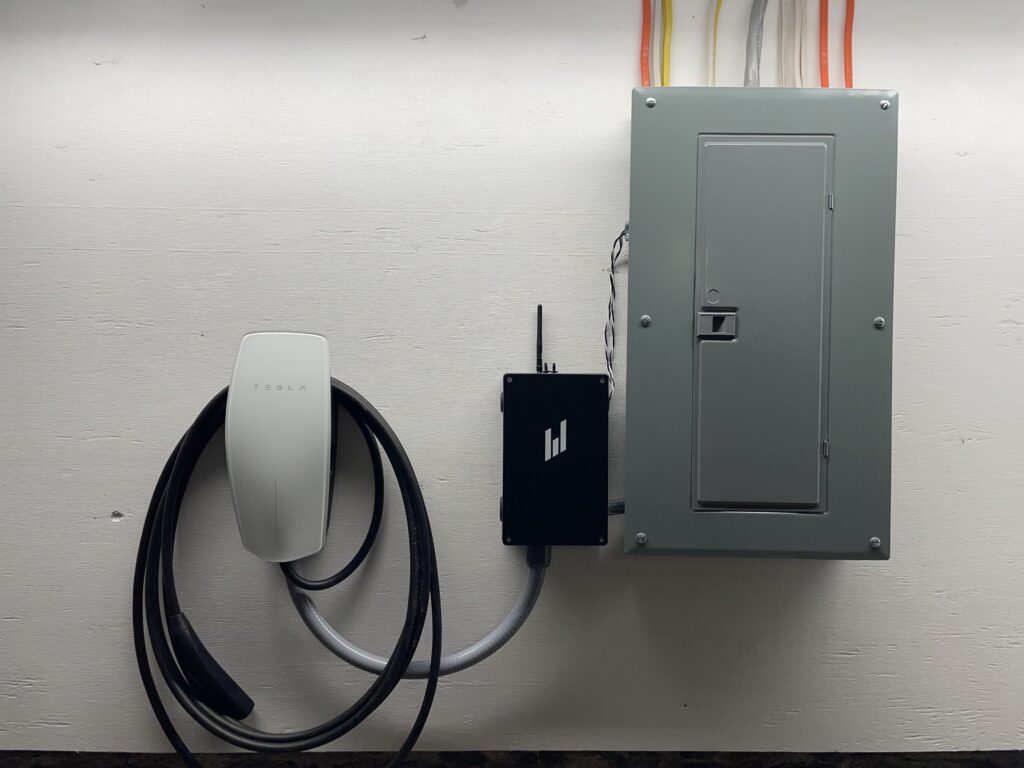Think of your electric panel as your home’s brain. A key nexus point that routes electricity from the grid throughout your home, the electric panel also keeps the amount of power coursing through wires at a safe level.
Today’s electric panels don’t have the built-in intelligence or real-time insights needed to deliver their full electrical capacity, however; an average U.S. home uses just 4 percent of its panel’s ampacity rating. This becomes a major problem for the energy transition, as bringing electric stoves, HVAC systems, vehicle chargers, and more into a home can demand costly electrical panel upgrades.
Stepwise, a Greentown Labs startup, is changing this dynamic by optimizing electric panels to tap into their full capacity. Its first product, EV Tap, balances the home’s energy demand by increasing power sent to an EV charger when other electrical demands are low and vice versa. This modulation enables an EV charger—which could use about 50 amps—to run in a house with a 100-amp electrical panel, with enough ampacity left over for other electricity needs.
“Our system can shift and defer loads,” says Jane Chen, the startup’s CEO and co-founder. “We can dial the EV charger back to, let’s say, 20 amps, and as a result we can keep the entire system within the safe limits. It’s all about adjusting and modulating the load in real time.”

Case Study: Stepwise’s Tech in Action
Let’s say you buy an EV and want to charge it at home.
An EV charger will cost about $600, with roughly a $1,000 installation fee. But if your electric panel is old or doesn’t have a high enough ampacity rating, you may be forced to upgrade your hardware—a hidden cost that could easily run $6,000-8,000, or even up to $20,000.
Stepwise’s EV Tap eliminates the need to upgrade your electric panel by utilizing the full ampacity of your existing system. The startup’s solution results in roughly 60 percent financial savings, and tax incentives for EV-charging infrastructure and rewiring rebates are available through the Inflation Reduction Act.
Today, Stepwise launched its EV Tap in the Greater Boston area, offering a white-glove installation service. The startup also announced a partnership with EcoAuto, an EV dealership in Tewksbury, MA.
While Stepwise is initially focusing on EV charging, its ambitions spread into every electrical component in a home.
“It goes back to Stepwise’s name—when we pursue electrification in the home, it’s usually incremental and step by step,” Chen says. “And so the way we’re approaching product design and solutioning mirrors that journey. The reason we started with EV chargers is because EV chargers, at least in the northeast, are the biggest triggers for electric-panel upgrades. We’re going to be working next on the R&D of a Heat Tap for heat pumps and potentially hot-water heaters.”
The startup’s customers include both homeowners and electricians, and it plans to sell through contractors and B2B2C channels. Chen emphasizes the importance of electricians’ role in the energy transition, while noting what the New Yorker dubs “the great electrician shortage.” Stepwise’s technology is meant to enable electricians’ work while shortening their project timelines and removing supply-chain delays.
Stepwise raised a $1.4M pre-seed in 2023 from 43North, NYU Innovation Venture Fund, NextFab Ventures, SBXi, and other angel investors. NextFab Ventures learned about Stepwise via Greentown’s Deal Flow Digest—an initiative of the incubator’s Investor Program designed to connect fundraising startups with relevant investors.
“We are seeking startups with clear value propositions in markets ripe for change,” says NextFab Ventures’ Director of Venture Services Todor Raykov. “It wasn’t difficult to identify Stepwise as one of those companies through the Deal Flow Digest. Subsequent conversations with Jane and her team convinced us that they have the people and tech that could help electricians and homeowners squeeze the most out of existing infrastructure.”
The six-person startup recently completed UL lab testing and, in addition to its Greater Boston product launch, is planning a utility pilot and a seed-round fundraise later this year.
Chen says her team has benefitted from engaging with fellow Greentown members and attending the incubator’s public-facing events.
“I speak so highly about Greentown to just about every climate founder,” she says. “I think a large part of it is due to the community—a community of different founders who have provided introductions or advice or shared their experiences. Everyone on my team loves the Greentown community.”
“The Greentown events draw the best audience,” Chen adds. “You can meet every type of investor, every type of climate founder, every other type of industry partner. Having exposure to them gave me confidence to approach larger companies at earlier stages, because I could hear them talk about what they’re looking for.”


